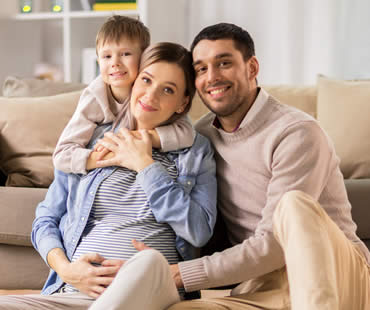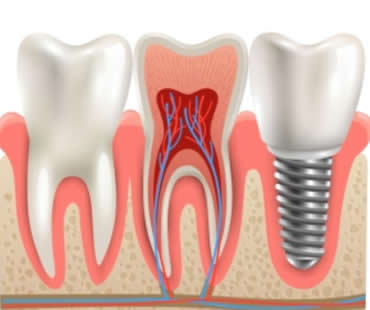
by Dr. Adkins | May 19, 2023 | Blog, Dental Topics 2, Implant Dentistry
If your quality of life has been compromised by tooth loss, dental implants may be the answer to your problem. Missing teeth can affect even the most basic daily activities like speaking and eating. If you are looking for a lifetime replacement for a missing tooth, dental implants should be your first choice for restoration.
A dental implant is an appliance that is affixed to the jaw bone and replaces natural teeth by supporting a crown or fixed denture. Once the implant has been placed, bone forms around the implant to make it a stable anchor for a restoration.
Any patient who is missing natural teeth is considered a candidate for implant placement. Just a few of the many reasons you should consider dental implants include:
- Your desire for a durable and long-term restoration
- Your desire to restore your facial appearance that has been altered by missing teeth
- Your desire to eat and speak normally
There are many benefits to dental implants. The placement of dental implants does not require any alteration of adjacent teeth, which is ideal as it preserves your natural tooth structure. Dental implants are cleaned the same way as your natural teeth, allowing you to maintain excellent oral health. Once the implant has been placed, you can eat all your favorite foods and speak without worrying about slipping or breaking.
When you replace a missing tooth with a dental implant, you will enjoy the same function, convenience, and natural look as you have with your other teeth. If you are missing teeth, talk to your dentist about the possibility of dental implants to restore your beautiful, healthy smile.
Our dental office is located in McDonough

by Dr. Adkins | Apr 7, 2023 | Blog, Cosmetic Dentistry, Dental Topics 2
Today’s cosmetic dentistry offers an extensive array of treatments and procedures to help restore a beautiful and healthy smile. While you may never have considered cosmetic dental procedures as a solution to your dental concerns, there are quite a few reasons you may want to consider for seeking cosmetic dental treatment:
- Crooked, cracked or decayed teeth can be corrected through bonding, crowns, and veneers, returning your smile to its once vibrant and healthy appearance.
- Decay and disease can cause you to lose teeth, creating gaps that hollow your face and age your appearance. Cosmetic dentistry offers a wide variety of options such as dental implants for restoring missing teeth, keeping your smile and face younger looking.
- Teeth that have yellowed or discolored over time due to wine, tobacco or staining foods can be lightened up to ten shades with professional teeth whitening treatments performed by a qualified cosmetic dentist.
- “Horsey” looking teeth or “gummy” smiles can be corrected through gum re-contouring or restructuring to create a younger, more appealing smile.
- Misaligned or gapped teeth can be straightened through orthodontia such as Invisalign that is virtually invisible and pain and hassle-free.
Some cosmetic treatments may be offered by your family dentist, but you may want to consider a consultation with a qualified cosmetic dentist to find out more about the full array of treatments available to address your cosmetic dental concerns. Many procedures are quick and painless, and can be combined with other cosmetic treatments to achieve the results you desire. With the help of cosmetic dentistry and proper oral care, you can be assured a confident, more perfect smile.
We look forward to seeing you in our McDonough dental office

by Dr. Adkins | Mar 31, 2023 | Blog, Cosmetic Dentistry, Dental Topics 2
Are your teeth misaligned? Do you have overlapping or crooked teeth? Did you have braces as a child but didn’t keep up with your retainer, and your teeth shifted back? If your smile is less than its best because of crooked teeth, you have several options to correct your issues.
Orthodontia such as braces or Invisalign can be utilized to straighten your teeth completely. Braces can be worn on the outside or the inside of the arch of your teeth. Braces on the inside are hidden from view when you smile or eat. Invisalign clear trays are options for people who want to be able to remove their appliance to eat and to brush their teeth.
Veneers can be made from porcelain, zirconium or resin composite material to reshape your smile. Veneers are thin shells that are permanently placed on top of your existing teeth. They can smooth the appearance of crooked teeth, bridge gaps, and cover chips and cracks. Veneers can also brighten the color of your teeth or can lengthen worn down teeth, leaving you looking more youthful.
A skilled cosmetic dentist may use a combination of these methods to achieve your dream smile. You may begin your straightening journey with braces to align your teeth followed by tooth-colored resin composite to reshape a malformed tooth. Perhaps you thought you wanted a full set of dental veneers, but once you see your teeth after Invisalign, you might choose only whitening instead. Only you and your cosmetic dentist can make the plan to achieve your ideal results.
If you want to pursue your best smile, talk to your cosmetic dentist today to learn what therapies are right for you and your smile goals. You won’t have to wait very long to begin enjoying the benefits of a healthy, straight smile.
Schedule your appointment at our McDonough dental office

by Dr. Adkins | Mar 24, 2023 | Blog, Dental Topics 2, Implant Dentistry
Most people will eventually lose one or more teeth. Even with vigilant oral care, accident or injury can cause the loss of a tooth. As we age, simple daily wear can cause damage to your teeth resulting in tooth loss. More commonly, periodontal disease or tooth decay will cause you to lose one or more teeth.
While you may think one missing tooth, especially one that does not actually show, is not a problem, most dentists recommend immediately replacing a missing tooth. Missing teeth are not only unappealing aesthetically, but also cause problems with your bite and speech. More critically, missing teeth can cause a chain reaction that results in more missing teeth. Because teeth shift to fill the space created by the missing tooth, those teeth become loose and may eventually fall out.
Another problem caused by missing teeth is jaw bone loss. The pressure of tooth roots into the bone cells keeps them from dissolving. If the root is missing, the bone cells die and the bone disintegrates. The loss of jaw bone results in facial collapse, giving you a caved in and much older appearance. Bone loss also causes remaining teeth to become loose and fall out.
One of the best options for replacing lost teeth are dental implants. The placement of dental implants and tooth restorations can prevent the bone loss that results from missing teeth. Not only do dental implants restore the look of your natural teeth, they also provide the function and feel of your original teeth. Dental implants allow you to return to eating and speaking normally, and return your smile to its natural glory. To find out if dental implants are a viable solution to your missing teeth, contact your dentist for an examination and evaluation. With dental implants you can restore the look, feel and function of your natural smile.
We treat patients from McDonough and the surrounding area

by Dr. Adkins | Mar 10, 2023 | Blog, Dental Topics 2, Family Dentistry
You may be diligent about keeping up with your yearly physical with your general physician, but you may not be as careful about seeing your family dentist as often as you should. People tend to neglect dental checkups, thinking that if their teeth aren’t hurting then there’s no reason to go to the dentist. This is untrue! Regular checkups and cleanings play an important role in your health and should not be overlooked.
The most obvious reason for every member of your family to go to your dentist is the potential medical benefits. Even if you perform proper oral hygiene routines at home, you can still develop medical problems that require intervention. Plaque and decay in hard-to-reach places may create cavities that need fillings. Gum disease can start off as minor gingivitis but worsen into advanced periodontal disease without treatment, and untreated gum disease might put you at higher risk for heart disease or diabetes. A tooth’s interior section called the pulp can become infected and die, eventually risking tooth loss. So skipping your regular dental examinations can have serious medical consequences.
In addition to protecting your health, family dentists keep your smile looking its best. Professional cleanings make your teeth brighter and healthier, and you’ll also likely end up with more self-confidence. At your dental visits, if you have concerns about the appearance of your smile, you can also get information and recommendations about cosmetic dental procedures that might improve your smile even more.
Another benefit of maintaining regular dental checkups is that it can cost you less money in the long run. If you think skipping a visit is financially smart, you’ll also be missing the opportunity to catch problems early and handle them before they reach the stage of expensive oral procedures.
It’s never the best idea to avoid dental care with your family dentist. Schedule and keep your appointments every six months for ideal oral health.
We treat patients from McDonough and the surrounding area

by Dr. Adkins | Feb 24, 2023 | Blog, Dental Topics 2, Implant Dentistry
Dental implants are used to replace individual or missing teeth or to anchor loose dentures. For many patients with these issues, traditional dental implants may not a viable option. For example, a patient who does not possess adequate bone levels to anchor the implants would not be a good candidate for traditional dental implants. With mini dental implants, the bone required to anchor the implant successfully is much less.
Thanks to advances in implant dentistry, these patients have other options. Mini dental implants have emerged as an attractive choice for cases that are not conducive to the placement of traditional implants. For the patient who has inadequate bone, the bone required to successfully anchor mini dental implants is much less. Unlike traditional implants, the placement procedure for mini dental implants is a minimally invasive procedure that can be completed in one appointment by a specially trained general or family dentist. Because the procedure is less involved, the pain and length of recovery is greatly diminished.
Patients who have existing health conditions that would preclude them from more invasive surgery may find mini dental implants an extremely appealing option. Mini implants are also a perfect choice for restoring one missing or damaged tooth. Should implant failure occur, grafting procedures would not be necessary because of the small size with mini dental implants.
Most importantly, mini dental implants maintain the look, feel and function of your natural teeth. While you have to wait months for traditional implants to fuse with the bone, mini dental implants are ready for immediate use. Talk to your dentist to determine if mini dental implants would be a good option for your dental restorations and get ready to face the world with a confident new smile.
If you need a dentist in McDonough contact us today








 (470) 665-5292
(470) 665-5292  E-Mail Us
E-Mail Us 
